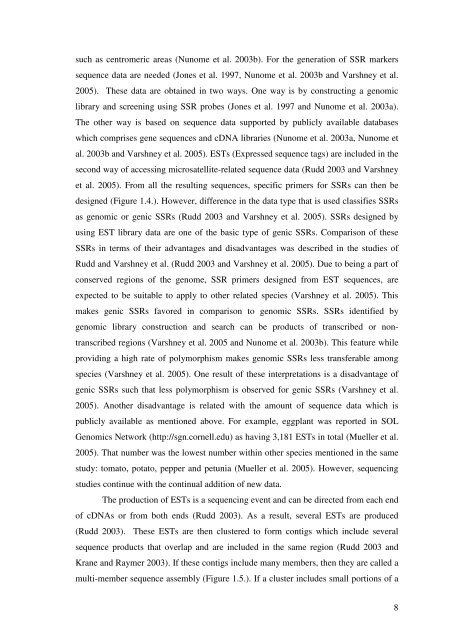determination of genetic diversity between eggplant and its wild ...
determination of genetic diversity between eggplant and its wild ...
determination of genetic diversity between eggplant and its wild ...
You also want an ePaper? Increase the reach of your titles
YUMPU automatically turns print PDFs into web optimized ePapers that Google loves.
such as centromeric areas (Nunome et al. 2003b). For the generation <strong>of</strong> SSR markers<br />
sequence data are needed (Jones et al. 1997, Nunome et al. 2003b <strong>and</strong> Varshney et al.<br />
2005). These data are obtained in two ways. One way is by constructing a genomic<br />
library <strong>and</strong> screening using SSR probes (Jones et al. 1997 <strong>and</strong> Nunome et al. 2003a).<br />
The other way is based on sequence data supported by publicly available databases<br />
which comprises gene sequences <strong>and</strong> cDNA libraries (Nunome et al. 2003a, Nunome et<br />
al. 2003b <strong>and</strong> Varshney et al. 2005). ESTs (Expressed sequence tags) are included in the<br />
second way <strong>of</strong> accessing microsatellite-related sequence data (Rudd 2003 <strong>and</strong> Varshney<br />
et al. 2005). From all the resulting sequences, specific primers for SSRs can then be<br />
designed (Figure 1.4.). However, difference in the data type that is used classifies SSRs<br />
as genomic or genic SSRs (Rudd 2003 <strong>and</strong> Varshney et al. 2005). SSRs designed by<br />
using EST library data are one <strong>of</strong> the basic type <strong>of</strong> genic SSRs. Comparison <strong>of</strong> these<br />
SSRs in terms <strong>of</strong> their advantages <strong>and</strong> disadvantages was described in the studies <strong>of</strong><br />
Rudd <strong>and</strong> Varshney et al. (Rudd 2003 <strong>and</strong> Varshney et al. 2005). Due to being a part <strong>of</strong><br />
conserved regions <strong>of</strong> the genome, SSR primers designed from EST sequences, are<br />
expected to be suitable to apply to other related species (Varshney et al. 2005). This<br />
makes genic SSRs favored in comparison to genomic SSRs. SSRs identified by<br />
genomic library construction <strong>and</strong> search can be products <strong>of</strong> transcribed or non-<br />
transcribed regions (Varshney et al. 2005 <strong>and</strong> Nunome et al. 2003b). This feature while<br />
providing a high rate <strong>of</strong> polymorphism makes genomic SSRs less transferable among<br />
species (Varshney et al. 2005). One result <strong>of</strong> these interpretations is a disadvantage <strong>of</strong><br />
genic SSRs such that less polymorphism is observed for genic SSRs (Varshney et al.<br />
2005). Another disadvantage is related with the amount <strong>of</strong> sequence data which is<br />
publicly available as mentioned above. For example, <strong>eggplant</strong> was reported in SOL<br />
Genomics Network (http://sgn.cornell.edu) as having 3,181 ESTs in total (Mueller et al.<br />
2005). That number was the lowest number within other species mentioned in the same<br />
study: tomato, potato, pepper <strong>and</strong> petunia (Mueller et al. 2005). However, sequencing<br />
studies continue with the continual addition <strong>of</strong> new data.<br />
The production <strong>of</strong> ESTs is a sequencing event <strong>and</strong> can be directed from each end<br />
<strong>of</strong> cDNAs or from both ends (Rudd 2003). As a result, several ESTs are produced<br />
(Rudd 2003). These ESTs are then clustered to form contigs which include several<br />
sequence products that overlap <strong>and</strong> are included in the same region (Rudd 2003 <strong>and</strong><br />
Krane <strong>and</strong> Raymer 2003). If these contigs include many members, then they are called a<br />
multi-member sequence assembly (Figure 1.5.). If a cluster includes small portions <strong>of</strong> a<br />
8

















